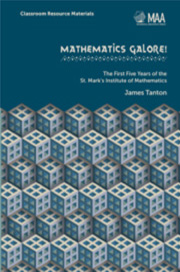Book contents
- Frontmatter
- Contents
- Introduction
- Newsletters and Commentaries
- 1 Arctangents
- 2 Benford's Law
- 3 Braids
- 4 CLIP Theory
- 5 Dots and Dashes
- 6 Factor Trees
- 7 Folding Fractions and Conics
- 8 Folding Patterns and Dragons
- 9 Folding and Pouring
- 10 Fractions
- 11 Integer Triangles
- 12 Lattice Polygons
- 13 Layered Tilings
- 14 The Middle of a Triangle
- 15 Partitions
- 16 Personalized Polynomials
- 17 Playing with Pi
- 18 Pythagoras's Theorem
- 19 On Reflection
- 20 Repunits and Primes
- 21 The Stern-Brocot Tree
- 22 Tessellations
- 23 Theon's Ladder and Squangular Numbers
- 24 Tilings and Theorems
- 25 The Tower of Hanoi
- 26 Weird Multiplication
- Appendices
- Index of Topics
- Classic Theorems Proved
- About the Author
3 - Braids
from Newsletters and Commentaries
- Frontmatter
- Contents
- Introduction
- Newsletters and Commentaries
- 1 Arctangents
- 2 Benford's Law
- 3 Braids
- 4 CLIP Theory
- 5 Dots and Dashes
- 6 Factor Trees
- 7 Folding Fractions and Conics
- 8 Folding Patterns and Dragons
- 9 Folding and Pouring
- 10 Fractions
- 11 Integer Triangles
- 12 Lattice Polygons
- 13 Layered Tilings
- 14 The Middle of a Triangle
- 15 Partitions
- 16 Personalized Polynomials
- 17 Playing with Pi
- 18 Pythagoras's Theorem
- 19 On Reflection
- 20 Repunits and Primes
- 21 The Stern-Brocot Tree
- 22 Tessellations
- 23 Theon's Ladder and Squangular Numbers
- 24 Tilings and Theorems
- 25 The Tower of Hanoi
- 26 Weird Multiplication
- Appendices
- Index of Topics
- Classic Theorems Proved
- About the Author
Summary
PUZZLER: A Weird Language
The language of ABABA uses only two letters, A and B, and any combination of them is a word. (Thus, for instance, ABBBBABAA and BBB are both words.) Also, strangely, a blank space, is considered a word.
The language has the property that any word that ends in ABA or in BAB has the same meaning as the word with them deleted. (Thus, for example, BBABA and BB are synonyms.) Also, any two consecutive As or Bs can be deleted from a word without changing its meaning. (Consequently, BAABBBA, BAABA, BBA, and A are equivalent words.)
Warm-up. Show that BA and A are synonyms.
Challenge. How many words of distinct meaning does this bizarre language possess?
[This is a strange puzzle. Its relevance is made clear in the next section.]
TIDBIT: Try This!
Take three strings, two colored red and one yellow, and tie them to the back of a chair so that the yellow strand lies in the middle position. Braid the three strands in any manner you care to choose. That is, cross adjacent strands over or under each other in any organized or disorganized fashion. Make sure when you are done that the yellow strand is in the middle position. Tie the three ends to a wooden spoon.
Here's something amazing!
Fact. No matter what braid you create (with the middle stand ending in the middle position), it is possible to untangle it by maneuvering the spoon back and forth between the strands.
- Type
- Chapter
- Information
- Mathematics Galore!The First Five Years of the St. Mark's Institute of Mathematics, pp. 19 - 24Publisher: Mathematical Association of AmericaPrint publication year: 2012



